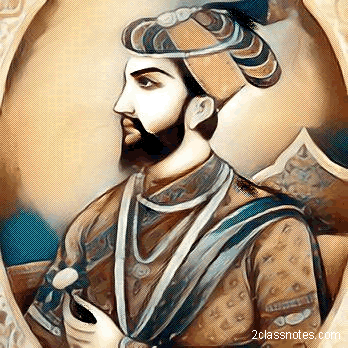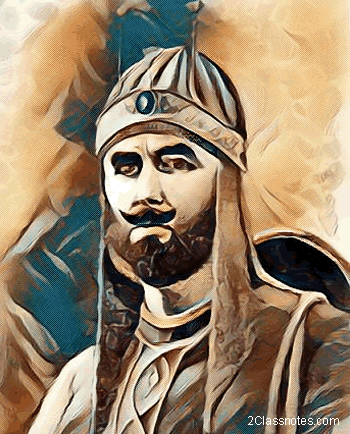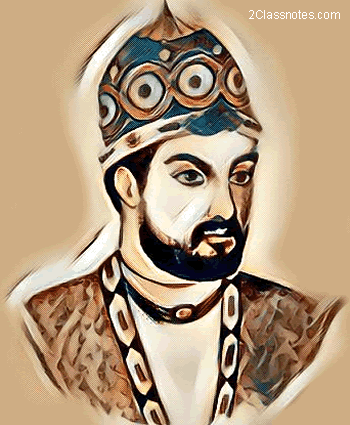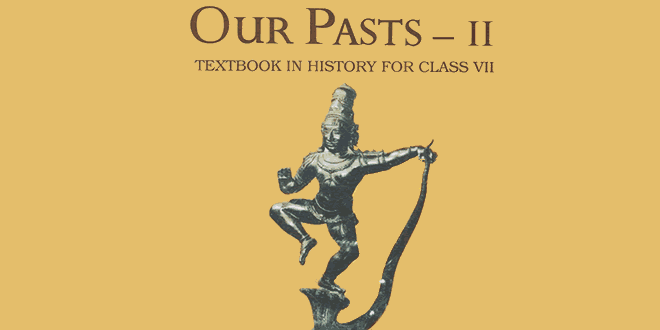The Delhi Sultans: NCERT 7th CBSE Social Studies Chapter 03
The Delhi Sultans – Question: Which ruler first established his or her capital at Delhi?
Answer: The Tomara Rajputs were the first rulers who established their capital at Delhi.
Question: What was the language of administration under the Delhi Sultans?
The Delhi Sultans – Answer: It was Persian.
Question: In whose reign did the Sultanate reach its farthest extent?
Answer: The Sultanate reached its farthest extent during the reign of Muhammad bin Tughluq.

Question: From which country did Ibn Battuta travel to India?
Answer: Ibn Battuta belonged to Morocco, Africa and travelled to India.
Question: According to the ‘circle of justice’ why was it important for military commanders to keep the interests of the peasantry in mind?
Answer: Peasantry was the backbone of the entire kingdom. The king could not do anything without it because it was the source of revenue. The soldiers got the salaries which came from this revenue. Hence, it was necessary to keep the peasants prosperous and happy because only then they could be able to pay revenue. Now, it becomes clear why the military commanders kept the interests of the peasantry at top.
Question: What is meant by the ‘internal’ and ‘external’ frontiers of the Sultanate?
Answer:
- The ‘internal’ frontier means the hinterland of the garrison town.
- The ‘external’ frontier means the areas beyond the hinterland of the garrison towns.
Question: What were the steps taken to ensure that muqtis performed their duties? Why do you think they may have wanted to defy the orders of the Sultans?
Answer: The steps taken are given below:
- Accountants were appointed by the state to check the amount of revenue collected by the
- Care was taken that the muqti collected only the taxes prescribed by the state and not more than that.
- It was also taken care that he kept only the required number of soldiers.
The muqtis may have wanted to defy the orders to the Sultans because their appointment was not hereditary. Also, their job was transferable. What is more, the conditions of service were severely imposed on them which they did not like.
Question: What was the impact of the Mongol invasions on the Delhi Sultanate?
Answer: The Delhi Sultanate mobilized a large standing army in Delhi. It posed a big administrative challenge.
- Alauddin Khalji constructed a new garrison town at Siri for his soldiers. He imposed taxes on land to feed the army at the rate of 50 percent of peasant’s yield. He began to pay the soldiers in cash.
- Muhammad Tughluq shifted people of Delhi to Daulatabad in south and thus converted Delhi into a garrison town. He also disbanded the army. He also paid the soldiers in cash.
Question: Do you think the authors of tawarikh would provide information about the lives of ordinary men and women?
Answer: I don’t think like that. It is because the authors of tawarikh lived in cities mainly Delhi. They were not in touch of village people. They often wrote their histories for Sultans in the hope of rich rewards. They had nothing to do with common mass. Hence, it was obvious that the information provided by them would lack ordinary men and women.
Question: Raziyya Sultan was unique in the history of the Delhi Sultanate. Do you think women leaders are accepted more readily today?
Answer: Yes, I think like that. The situation has changed today. Due to the spread of education people now realize the potential of women. So, they have started accepting them as leaders. Even in rural areas now we see women Sarpanches and Councillors.
Question: Why were the Delhi Sultans interested in cutting down forests? Does deforestation occur for the same reasons today?
Answer: The Delhi Sultans cleared the forests in the Ganga-Yamuna doab and gave these lands to peasants in order to encourage agriculture. They also established new fortresses and towns in these lands to protect trade routes and to promote regional trade.
No, deforestation does not occur for the same reasons today. Nowadays, vegetation cover is being reduced due to over-population, urbanization and commercialization.
Question: Find out whether there are many buildings built by the Delhi Sultans in your area. Are there any other buildings in your area that were built between the twelfth and fifteenth centuries? Describe some of these buildings, and draw sketches of them.
Answer: Students are suggested to visit their city and prepare the list themselves. They can take help of their parents.
Question: Who defeated the Tomara Rajputs and when?
Answer: The Chauhans of Ajmer defeated the Tomara Rajputs in the middle of the 12th century.
Question: When did the Delhi Sultanate lag its foundation?
Answer: The Delhi Sultanate laid its foundation in the beginning of the thirteenth century.
Question: Name the five dynasties that together made the Delhi Sultanate.
Answer:
- Early Turkish rulers (1206—1290)
- Khalji dynasty (1290—1320)
- Tughluq dynasty (1320—1414)
- Sayyid dynasty (1414—1451)
- Lodi dynasty (1451—1526).
Question: Mention the sources that provide a lot of information about the Delhi Sultans.
Answer: Inscriptions, coins, architecture and history written in Persian by learned authors are some of the most important sources that provide a lot of information about the Delhi Sultans.
Question: Why did the authors of tawarikh write their histories for Sultans?
Answer: They did so in the hope of rich rewards.
Question: Why was Raziyya removed from the throne?
Answer: Being a woman ruler she was not favored by anyone. She ruled just for four years and was finally dethroned in 1240.
Question: What is a mosque called in Arabic?
Answer: It is called a masjid.
Question: What is the literal meaning of mosque?
Answer: It refers to a place where a Muslim prostrates in reverence to Allah.
Question: What is called the qibla?
Answer: The direction towards which Muslims turn while offering prayer or namaz.
Question: Why did the early Delhi Sultans favor their slaves?
Answer: The slaves were totally dependent on their master. Therefore the Sultan could trust and rely upon them.
Question: What was the duty of the muqtis?
Answer: The duly of the muqtis was to lead military campaigns and maintain law and order in their iqtas.
Question: Why were accountants appointed by the state?
Answer: They were appointed to check the amount of revenue collected by the muqtis.
Question: Why did the authors of Persian tawarikh criticize the Delhi Sultans?
Answer: They did not like the Sultanate’s policy of appointing the ‘low and base-born’ to high offices.
Question: Name the three types of taxes collected during the Sultanate period.
Answer:
- Tax on cultivation called Kharcy and amounting to about 50% of the peasant’s yield.
- Tax on cattle.
- Tax on houses.
Question: For how many years the Suri dynasty rule?
Answer: The Suri dynasty ruled for only 15 years.
Question: Who were the authors of tawarikh? Write in brief about them.
Answer: The authors of tawarikh were learned men. They were secretaries, administrators, poets and courtiers who recounted events as well as advised rulers on governance, emphasising the importance of just rule. The authors of tawarikh lived in cities mainly in Delhi and therefore they were cut off from the village. They used to write histories in praise of the Sultans and in return got rich rewards. These authors advised rulers that they should follow an ideal social order based on birthright and gender distinctions. Common mass had nothing to do with their ideas.
Question: Who was Raziyya? Why was she not accepted as a Sultan inspite of being talented?
Answer: Raziyya was Sultan Iltutmish’s daughter. She became Sultan in 1236. She was very talented. According to the chronicler of the age, Minhaj-i-Siraj, she was more able and qualified than all her brothers. But she was not accepted when she became a ruler. Those were the days when women were not allowed to enjoy independent identity. They were supposed to be subordinate to men. This led to her removal from the throne in 1240.
Question: What were the four stages in the making of a manuscript?
Answer: The four stages in the making of a manuscript are:
- Preparing the paper
- Writing the text
- Melting gold to highlight important words and passages
- Preparing the binding.
Question: How did the Khaljis and Tughluqs help the people of humble birth? How did it lead to political instability?
Answer: The Khaljis and Tughluqs raised people of humble birth who were often their clients, to high political positions. They were appointed as generals and governors. However, this also introduced an element of political instability. Slaves and clients, the people of humble birth, were loyal to their masters and patrons but not to their heirs. Now Sultans had their own servants. As a result the accession of a new monarch often saw conflict between the old and the new nobility.
Question: Why did large parts of the subcontinent remain outside the control of the Delhi Sultans? What were the repurcussions?
Answer: Large parts of the subcontinent remained outside the control of the Delhi Sultans because they were very far from Delhi. For example, it was difficult to control Bengal from Delhi. This helplessness of the Delhi Sultans paved the way for distant provinces to get independence. Even in the Gangetic plain there were forested areas that Sultanate forces could not penetrate. It was a golden opportunity for the local chieftains to establish their rule in these regions.
Question: How did the chieftains arrange for their defence?
Answer: The chieftains fortified themselves in mountains, in rocky, uneven and rugged places as well as in bamboo groves. The bamboo had unique features. It was strong and even fire could not affect it because its several party were intertwined making them very strong. The chieftains lived in these forests which served them as rampart. They had everything necessary for life such as cattle, crops, water, etc. inside the forests. Thus, they were safe. Only powerful armies could subdue them.
Question: Why did Alauddin control the prices of goods in Delhi? What did he do for this?
Answer: Alauddin gave great importance to his soldiers because it was they who could defend the Sultanate from outsiders. He decided to pay their salaries in cash rather than iqtas. The soldiers would buy their supplies from merchants in Delhi and it was thus feared that merchants would raise their prices. To stop this, Alauddin controlled the prices of goods in Delhi. For this Alauddin instructed officers to carefully survey prices. The merchants who did not sell their goods at the prescribed rates were punished.
Question: Describe in brief Tughluq’s policy of ‘token’ currency.
Answer: Tughluq did not control prices of the goods. Instead, he used a token currency, made out of cheap metals, and not of gold and silver. People in the 14th century did not believe in these coins. They saved their gold and silver coins and paid all their taxes to the state with this token currency. This cheap currency could be counterfeited easily.

Question: Who was Sher Shah Suri? What do you know about his administration?
Answer: Sher Shah Suri (1540—1545) established a powerful state. He started his career as the manager of a small territory for his uncle in Bihar and eventually challenged and defeated the Mughal Emperor Humayun. Sher Shah captured Delhi and established his own dynasty known as the Suri dynasty. Although the Suri dynasty ruled for only a short period i.e. 15 years, it introduced an administration that borrowed elements from Alauddin khalji and made them more efficient. The great emperor Akbar followed the techniques of Sher Shah’s administration while consolidating the Mughal Empire.
Question: Give an account of Alauddin’s administrative measures.
Answer: During the reign of Alauddin Khalji Mongol attacks increased. It was a huge administrative challenge for the Sultan. He introduced several administrative measures:
- Alauddin Khalji raised a large standing army as a defensive measure.
- He constructed a new garrison town known as Siri for his soldiers.
- The soldiers had to be fed. This was done through the produce collected as tax from lands between the Ganga and Yamuna. Tax was fixed at 50% of the pleasant’s produce.
- He paid his soldiers cash salaries rather than iqta. This was done in order to make soldiers able to buy their supplies from merchants in Delhi. It was feared that merchants would raise their prices. In order to stop this Alauddin controlled the prices of goods in Delhi. Prices were carefully surveyed by officers and merchants who did not sell at the prescribed rates were punished.
Alauddin’s administrative measures were successful because he efficiently withstood the threat of Mongol attacks.

Question: Give an account of Muhammad Tughluq’s administration.
Answer: The early years of Muhammad Tughluq’s reign faced Mongol attacks, which were curbed by Tughluq’s sincere efforts.
- He took several administrative measures like Alauddin Khalji he also raised a huge standing army in Delhi.
- He got emptied the oldest of the four cities of Delhi (Delhi-i Kunba) in order to garrison his soldiers there. The residents of the old city were sent to the new capital of Daulatabad in the south.
- He made arrangements for the collection of produce as tax to feed the soldiers. As it was very difficult to maintain a large number of soldiers the Sultan levied additional taxes which coincided with famine in the area.
- Muhammad Tughluq paid soldiers cash salaries. For this he introduced ‘token’ currency made of cheap metals. People in the 14th century did not trust these coins. They saved their gold and silver coins and paid all their taxes to the state with this token currency.
Question: ‘Muhammad Tughluq’s administrative measures were a failure’. Explain with examples.
Answer: Muhammad Tughluq’s administrative measures were a failure, we can prove this statement with following points:
- He campaigned into Kashmir which was finally a disaster. He then gave up his plans to invade Transoxiana and disbanded his large army.
- His administrative measures created problems. He shifted the residents of the old city to the new capital of Daulatabad in the south. People did not like this step taken by Muhammad Tughluq. They resented collectively.
- Tughluq, in order to meet the expense of maintaining a large number of soldiers, levied additional taxes which increased the burden of common people.
- The famine in the Ganga-Yamuna belt led to widespread rebellion.
- Muhammad Tughluq’s policy of ‘token’ currency also proved a failure. People of the 14th century did not trust this currency. They were very smart. They saved their gold and silver coins and paid all their taxes to the state with the token currency. This cheap currency could also be counterfeited easily.
 Class Notes NCERT Solutions for CBSE Students
Class Notes NCERT Solutions for CBSE Students


